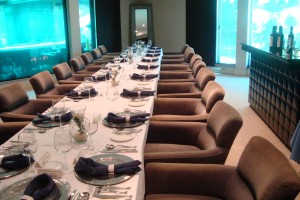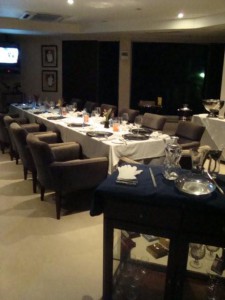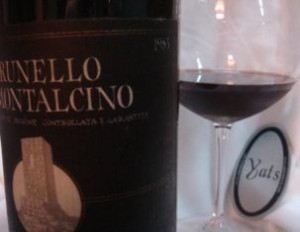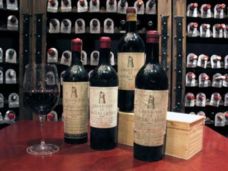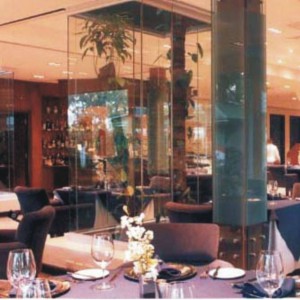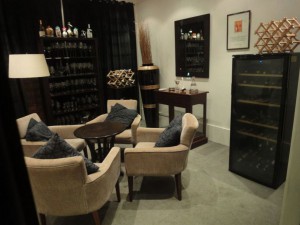The Search for the Perfect Steak – 11July18
June 8, 2011
Aging your own beef. ‘Secret’ spices — from the supermarket. Our reporter’s quest for a steakhouse-quality meal at home.
By KATY MCLAUGHLIN
I’m standing in the kitchen of Brooklyn, N.Y.’s Peter Luger Steak House, inches from a wall of broilers, fearing that I, like the Flintstone-size porterhouses sizzling behind me, might be developing a heavy char. Waiters rush to pick up hissing plates of beef, while cooks spear steaks onto huge, pointy forks and, in a flash, dissect them into chunks.
After five years of attempting to perfect a method for cooking steak at home, I’ve come to one of the most renowned steakhouses in the country to learn how to make meat like a pro. The mission is personal: For all the hundreds of steaks I’ve set under my broiler throughout the years, I’ve never yet managed to duplicate that most irresistible of meals, the steakhouse steak.
So over the past three months, I’ve taken a journey into the world of steak. I encountered a passionate subculture of foodies who risk microbial Armageddon and turn their refrigerators into makeshift aging caves. I hung out in busy steakhouse kitchens where one false step can send a person tumbling onto the business end of a 10-inch chef’s knife. And while practicing one pro’s shopping techniques at my neighborhood Costco, I studied the lines of marbling in a pack of T-bones as if I were reading tea leaves.
Even as the price of prime beef skyrockets — partially an odd side effect of the nation’s new love of ethanol, which is driving up the price of corn used to feed cattle — I discovered there’s a trick to making cheaper choice cuts nearly as flavorful and tender as prime. And I learned why the most critical gadgets in the pro steak chef’s grilling arsenal are a humble cast-iron pan and tongs.
Americans have grown accustomed to the taste of top-drawer steak since the steakhouse industry began to boom in the early 1990s. But for years, there was a still a difference between the beef served up at these pricey restaurants and the best cuts sold in most stores. That began to change toward the end of the ’90s, when more retailers started carrying USDA prime, sometimes dry-aged. The “prime” label is the highest grade assigned to beef by the Agriculture Department based on the amount of marbling, or lines of fat, it contains. Lesser grades, such as choice and select, have less marbling.
Whole Foods Market has built 16 dry-aging caves in its stores since 1999, and Wegmans, an East Coast supermarket chain, started selling prime, dry-aged beef in all 70 of its stores three years ago. Donald Trump now hawks fancy beef through the Sharper Image catalog, and mail-order company Allen Brothers says business was up 80% last year from the year prior.
But the good stuff doesn’t come cheap. At Peter Luger, for example, a porterhouse for two costs $81.90 — or roughly $2.04 an ounce. You can cook a similar steak at home by buying a porterhouse package through the restaurant’s online butcher shop for $206.20, or about $2.71 an ounce (though you get steak sauce, chocolate coins and shipping, too).
Whereas restaurants might eat margin losses or rejigger the rest of the menu to offset losses, retailers set their prices high partly as a hedge against market fluctuations. This year, for example, wholesale prices for USDA prime steaks have jumped 8% to 9% from the same period last year — and that’s on top of a 15% increase from 2005 to 2006. These are historically large jumps, according to market analyst Cattle-Fax, reflecting the high demand for prime.
Fueling the increase are corn prices that have risen by 50% this year compared with last year, partly a result of rising ethanol demand. Ethanol uses up 26% of the total U.S. corn crop — up from 11% five years ago, according to USDA numbers. In response, the beef industry is cutting the number of days it feeds cattle grain, which translates into fewer cattle developing the marbling that merits a prime grade.
My personal steak life can be divided into the years before and after I met my husband. Raised in Uruguay, where cattle outnumber people by nearly 4 to 1, he grew up steeped in a cuisine that can be basically summed up in two words: grilled beef.
Before we met, I considered steak beneath my culinary aspirations, and on the rare occasions I did cook it, I usually picked it up at the local grocery store. At most stores, meat doesn’t tout any grade, a pretty good sign that it’s USDA select, a tougher, less-flavorful grade a notch below USDA choice. After my husband came into the picture, I started buying USDA choice beef at Costco for biweekly steak dinners.
As it happens, that’s exactly where the pros told me to shop to find great beef — the first step in my steak-cooking quest. Elias Iglesias, the 14-year veteran executive chef at the New York branch of Morton’s, says though he uses prime at the restaurant, he happily cooks choice meat at home, often buying whole loins at big-box stores such as BJ’s or Costco. If you like filet mignon, look for a cut labeled “beef tenderloin”; for strip steaks, buy “strip loin.”
Mr. Iglesias then cuts them into even, 1┬Į- to 2-inch steaks himself (filet should be cut 2┬Į inches thick). The 33-year-old recommends examining packages of precut steaks closely for the degree of marbling. In my experience, well-marbled choice steaks can taste as good as prime if they are properly aged and cooked.
While prime beef is slightly scarcer than usual right now — accounting for about 2.5% to 3% of all beef on the market, down from 3.1% last year — choice beef is plentiful, at roughly 58% of all beef, compared with 56% last year. Beef grade is largely determined by nature, though the industry tries, through genetics and feeding practices, to raise cattle so that they will earn a choice grade.
Though shopping turned out to be fairly simple, the next step was complex, arduous and even a bit scary. One of the most passionate debates among steak lovers has to do with the aging process. Wet aging, which is how Morton’s handles its beef, involves vacuum packing the meat in a bag for several weeks after it is slaughtered. The technique allows enzymes in the beef time to break down and tenderize muscle tissue.
At Peter Luger, where the tin ceilings and beer-hall-style decor hark back to its 120-year history, they go a step further and dry age the meat. There, several tons of beef sit on wooden racks in a huge dry-aging room that has a distinctly pungent, nutty, somewhat sour odor. This arcane and expensive technique — what one beef expert described to me as “a process of controlled rotting” — is what gives Peter Luger beef its signature flavor. To my mind, dry-aged beef is the best there is because it’s not only tenderized, but much of the liquid evaporates, leaving behind a smaller, but more intensely flavored piece of meat.
Trolling through meat threads on food Web sites Chowhound and eGullet, I discovered a whole subculture of people who forgo buying dry-aged beef and prefer to do it themselves, despite warnings from health experts. Cook’s Illustrated, the cooking magazine that rigorously tests recipes, and the Food Network’s Alton Brown have also both published recipes for home-aging beef.
Jack Bishop, editorial director of America’s Test Kitchen, which owns Cook’s Illustrated, says “if safety is your No. 1 concern, you probably don’t want to go down the road of aging your beef,” but that he believes it is fairly safe if cooks observe strict hygiene and limit the aging to four days. Alton Brown also says aging can be safe if properly done.
But everyone from food scientists to butchers to cooking schools say aging beef at home is a huge risk. “The dangers outweigh the benefits,” says Brian Buckley, who specializes in food safety at the Institute of Culinary Education. Unless it’s possible to achieve a consistent meat temperature below 40 degrees, a controlled humidity level, constant air flow, strict sanitation and expert butchering, says Mr. Buckley, bacteria, yeasts and mold can easily develop, both within a vacuum-sealed pack or outside of it; any of these can easily lead to food-borne illness.
Cooking the meat to 165 degrees would kill off pathogens, but the meat would be like shoe leather by then. For medium rare, most chefs cook steak until the interior is 125 to 130 degrees (it will continue to rise in temperature by a further five to 10 degrees as it rests) and has a rosy, but not blood-red, hue.
None of this stops David Farbman, an investment banker in Boston, from dry aging the sirloins he buys from a butcher shop. He leaves roasts in the fridge for up to 10 days, then carefully trims away the desiccated parts before slicing steaks. Melanie Wong in San Francisco wet ages hanger steak by leaving it in vacuum-sealed bags for up to a week beyond the “consume by” date. As far as food safety goes, Ms. Wong, a pharmaceutical consultant, says her meat passes “a sniff test.”
Not to be outdone, I turned my own kitchen into a laboratory. I spent more than $100 for wire racks, baking trays, ice packs, plus, at Costco, two beef tenderloins and two whole top loins — around $61 each. My plan was to dry age half the beef, then compare it to the other meat, which was essentially wet aging in vacuum-sealed bags.
I started by cleaning all my equipment (Mr. Buckley recommends diluted bleach) then laid a tenderloin and a strip loin on baking racks set into baking sheets lined with paper towels. I put them into the lower half of the refrigerator, which I lined with ice packs. Because tenderloin is already tender, I aged it for only two days, but the strip got a week.
I tried to create air flow by installing a hand-held fan in the fridge, but the battery gave out in a couple of hours, so I just hoped for the best. Before slicing the meat into steaks, I trimmed every last exterior scrap of dry meat.
A series of blind taste tests with my husband and my parents revealed that even this limited amount of dry aging (steakhouses age meat for strip steaks three weeks or more) was highly effective. Everyone preferred the richer, more toothsome dry-aged meat over the blander wet-aged filet. While both strip steaks were yummy, the wet aged tasted hammy compared with the beefier, more intense dry-aged.
Still, even my dry-aged meat didn’t have the flavorful crust of steakhouse steak. So my next challenge was figuring out a better way of cooking the meat to show off its taste.
I turned to the professionals, requesting one-on-one instruction from the chefs at Morton’s and Peter Luger. To my surprise, I found that beyond cooking in broilers cranked up to at least 800 degrees, which sears the exterior of the meat, the two steakhouses did about everything else differently.
At Morton’s, I saw large trays of raw meat sitting out beside the stove. Mr. Iglesias explained that the restaurant lets steak sit outside the refrigerator for about an hour — as much as the health code allows — but “at home I let them sit for two hours,” he admitted. The purpose: To raise the internal temperature slightly, so that the center doesn’t stay cold while the exterior burns. This turned out to be a key technique for cooking the perfect steak.
To imitate the golden crust the steakhouse broiler provides, Mr. Iglesias suggests searing steaks in an extremely hot cast-iron pan coated with a little oil and flipping them with tongs, never a fork, which releases juices. Then, the steaks should be moved to the center rack of a 400-degree oven to finish cooking. Of course, it’s wonderful to use an outdoor grill — searing first over high heat and then moving the steaks to a cooler part of the grill to finish cooking — though not practical in winter.
Morton’s also seasons steak with a secret salt-and-spice blend. Mr. Iglesias says Lawry’s Seasoned Salt is a perfectly good alternative (though I, a purist, just use kosher salt). After cooking, he says it’s critical to let the meat rest for a few minutes before eating it, to allow the juices to reabsorb into the meat.
Over at Peter Luger, I was in for a shock. Chef Maciej Truskolaski and third-generation co-owner Jody Storch both seemed sheepish as I positioned myself in front of a row of hot ovens, notebook in hand, ready to soak in their genius. When I saw the technique, I understood why: Mr. Truskolaski grabbed a cold porterhouse, placed it on the grill rack of the broiler and sprinkled it with some salt. He then removed it while it was still raw inside, cut it into piece, put it on a plate, and broiled it to medium-rare.
“Don’t tell people to do this at home, all the juices will run out,” Ms. Storch said, acknowledging that cutting a piece of steak into chunks before it has been fully cooked is a notorious no-no in steak cookery (as is using forks to flip meat, as is starting with cold steak). “We just do it this way because it’s what we’ve always done,” Ms. Storch said.
Once back in my home kitchen, I began to do things as I’d never done: Using my hand-cut, USDA choice dry-aged strip steak, I applied the cast-iron pan sear and finished the steaks in the oven. While I wouldn’t say that my steaks are an exact replica of steakhouse beef, for a fraction of the price they get darn close.
Lessons From the Pros
Master Recipe
2 steaks; cut strip steaks or rib-eyes about 11/2 inches thick, filet mignon, 21/2 inches
2 teaspoons grapeseed or canola oil
Kosher salt
ŌĆó Remove steaks from refrigerator 2 hours before cooking time. Dry them with a paper towel.
ŌĆó Preheat oven to 400 degrees, with a rack set in the middle.
ŌĆó Heat a heavy, cast-iron skillet over medium-high heat, until a few drops of water sprinkled in the hot pan evaporate within 3 seconds.
ŌĆó Coat the bottom of the pan with 2 teaspoons of grapeseed or canola oil.
ŌĆó Liberally salt the steaks with kosher salt, about 3/4 teaspoon for each steak.
ŌĆó Place steaks in pan and sear for 2 minutes on each side, flipping only once with tongs.
ŌĆó Transfer the steaks, still in the pan, to the oven and roast for roughly 8 to 9 minutes for 11/2-inch steaks to achieve medium-rare (an instant-read thermometer should register between 125 and 130 degrees).
ŌĆó Let the steaks rest, under a tent of aluminum foil, for 5 minutes before serving.
Two Ways to Dress It Up
Bobby Flay’s Coffee Spice Rub for Strip Steaks
Makes 1 cup
1/4 cup ancho chile powder
1/4 cup finely ground espresso-roast coffee beans
2 tablespoons sweet paprika
2 tablespoons dark brown sugar
1 tablespoon dry mustard
1 tablespoon salt
1 tablespoon freshly ground black pepper
1 tablespoon dried oregano
1 tablespoon ground coriander
2 teaspoons ground ginger
2 teaspoons chile de ├Īrbol powder or cayenne (optional)
ŌĆó Combine all the ingredients in a bowl or a jar with a tight-fitting lid and mix well. Store in a cool place. Omit the chile de ├Īrbol if you want a milder rub. To use: Proceed with the master recipe, replacing the kosher salt with a coating of 1 tablespoon of spice rub on each steak, plus salt to taste. During searing, there will be a bit of smoke, but the steaks are not burning; it is just smoke from the spices in the rub. Works on all steaks but is best on strip steaks or rib-eyes.
Sauce B├®arnaise for Filet Mignon
Active prep time: 20 minutes
Cooking time: 5 minutes
Makes 1 cup
For the hollandaise sauce:
3 large egg yolks
12 tablespoons (11/2 sticks) unsalted butter, melted and cooled
1 teaspoon fresh lemon juice
Dash of Tabasco sauce
Dash of Worcestershire sauce
For the tarragon reduction:
2 tablespoons white-wine vinegar
2 tablespoons white wine
1 teaspoon chopped fresh tarragon
1/2 small shallot, finely chopped
Kosher salt and ground white pepper
ŌĆó In a medium stainless steel mixing bowl, whisk together the egg yolks and 1 tablespoon water. Place the mixing bowl over a pot of barely simmering water, making sure that the bottom of the bowl does not touch the water. Whisk continuously until the mixture is pale yellow and foamy and just begins to thicken, about 1 minute. Take care not to overcook the eggs or they will curdle.
ŌĆó Remove the bowl from the pot of simmering water and slowly pour the melted butter (the butter should be warm; if it’s too hot, the sauce will break) into the eggs while continuing to whisk the mixture until all the butter is incorporated. Add the lemon juice, Tabasco and Worcestershire, and hold in a warm area (i.e., side of stove), while you make the tarragon reduction.
ŌĆó To make the reduction: In a small saucepan over medium-high heat, combine the vinegar, wine, tarragon and shallot. Bring to a simmer and cook until enough liquid evaporates so that it barely coats the bottom of the pan, about 3 minutes.
ŌĆó To finish the sauce, whisk the tarragon reduction into the hollandaise sauce. Return the sauce to the warm area until ready to use.
ŌĆó Works with any steak but is best with filet mignon, cooked according to the master recipe.
Source: http://online.wsj.com/article/SB118920026703920971.html
Best place to unwind in Angeles City Pampanga Philippines is to wine and dine at Yats Restaurant
Top Fine dining in Manila Philippines, Wine and Dine at Yats Restaurant & Wine Bar, Wine Spectator Best of Excellence Award for top 600 Best Restaurant Wine List in the World, private rooms, vegetarian menus and healthy cuisine available also
Residents of Manila travel out of town for a short getaway up north visit Angeles city, Clark, Pampanga, Philippines to wine and dine and enjoy a special dinner at the best restaurant in the country. Even people from Subic and Cebu travel to Clark to enjoy a special evening and some great food and rare vintage wine at this fine dining restaurant.
Recent opinion survey of frequent travelers heading north towards Subic and Clark Pampanga revealed that the number one most frequently visited fine dining restaurant in Pampanga is Yats Restaurant & Wine Bar located in Clark Philippines. It is generally regarded as the best restaurant in Clark Pampanga as well as a good night out place near Angeles City.
More and more foodies, critics, connoisseurs, frequent diners and wine lovers from Manila travel out of town north to Clark Pampanga, looking for restaurant that serves the best food in Pampanga, choose to wine and dine in famous fine dining Yats Restaurant & Wine Bar. Most visitors enjoy the fine vintage wines from the cellars of this fine dining restaurant. Some purchase a few to bring back home to Manila.
Many frequent diners from Manila, Angeles City, Subic and other major cities in Asia travel to North Luzon Pampanga Clark Freeport to enjoy good food in a romantic fine dining restaurant. On their list of requirements is a good wine list that not only offers a wide selection of wines from different countries but also older vintages that can be enjoyed now and not ten years later. Classic fine dining is the experience that guests of Clark Philippines’ Yats Restaurant & Wine Bar offers to their guests. Although this is an upscale fine dining establishment, families find the restaurant to be very children friendly.
Private dinners can be accommodated in this famous restaurant located in Mimosa, at the heart of Pampanga Clark Freeport. Private rooms suitable for 4 to 24 can be reserved in advance for company and personal functions and events. This fine dining restaurant is a very popular venue for small wedding receptions, social events, company board meetings and annual parties. Many travel all the way from Manila to hold their group dinners and private parties in this famous restaurant in Clark Pampanga.
Philippines Pampanga Clark Freeport is well known for its safety and security, boasting the lowest crime rates in the country. The absence of traffic and pollution also helps to position Clark Pampanga at the top of touristsŌĆÖ list of destinations for vacation and get-away from Manila with families and friends.
Wine lover’s choice – Yats Restaurant and Wine Bar – for the most impressive and practical wine list in the Philippines, over 2700 selections, enough to satisfy the most fastidious connoisseurs. Wine lovers and gourmand foodies from Hong Kong, Singapore, Japan, Korea and Malaysia dine at Yats Restaurant & Wine Bar when they visit Philippines and bring home some rare vintage wines too back home from Clark Pampanga.
An excellent wine list is not just about 1st growth and cult Cabernet but a seemingly unending selection of affordable aged vintage wines that are not available anywhere else, not even in the best wine shops around town. Yats Restaurant which is located in Clark Pampanga has just that.
Fine dining Yats Restaurant and Wine Bar is frequently used for private meetings, corporate events and social functions. Located in Mimosa Leisure Estate at the heart of Clark Freeport Zone, this top rated resto bar is a highly recommended meeting destination in Pampanga, Philippines.
For comments, inquiries and reservations click on Click here for inquiry and reservations
Restaurant@Yats-International.com
(045) 599-5600
0922-870-5178
0917-520-4401
Ask for Pedro and Rechel
Getting to this fine dining restaurant of Angeles City Clark Freeport Zone Pampanga Philippines
How to get to this fine-dining restaurant in Clark Pampanga? Once you get to Clark Freeport, go straight until you hit Mimosa. After you enter Mimosa, stay on the left on Mimosa Drive, go past the Holiday Inn and Yats Restaurant (green top, independent 1-storey structure) is on your left. Just past the Yats Restaurant is the London Pub.
Yats Restaurant & Wine Bar
Mimosa Drive past Holiday Inn, Mimosa Leisure Estate,
Clark Freeport Zone, Pampanga, Philippines 2023
Manila Sales Office
3003C East Tower, Phil Stock Exchange Center,
Exchange Rd Ortigas Metro Manila, Philippines 1605
(632) 637-5019 0917-520-4393 Rea or Chay
For any assistance in planning and organizing a wedding ceremony, indoor or outdoor garden reception or to find other wedding service providers, Click here to contact us click here
For assistance in hotel and resort bookings in Clark, Pampanga, Philippines, log on to
http://www.HotelClarkPhilippines.com
To buy wine in Manila, Pampanga, Angeles City, Clark or Subic please log on to http://www. ClarkWineCenter.com
To inquire with the highly recommended beach resort hotel in Clark Pampanga visit http://www.ClearwaterPhililippines.com
For more information about Clark, Pampanga, Philippines log on to
http://www.ClarkPhilippines.com
If this article about Clark is useful to you, please click here to contact us to tell us what more you wish to know about this article or Clark Philippines, which can be something about Clark investment, about Clark resorts, about Clark Swimming and Leisure or simply general news about Clark.
Please send questions to Editor@ClarkPhilippines.com. Leave your name, email address, contact numbers and we will get back to you as soon as possible. Information received will not be disclosed.


